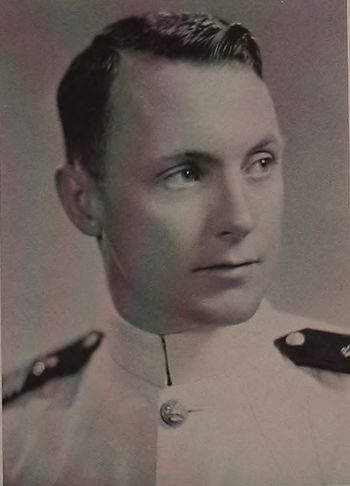WILLIAM CLAY, JR., MAJ, USMC
William Clay, Jr. '41
Lucky Bag
From the 1941 Lucky Bag:
WILLIAM CLAY, JR.
Stephenville, Texas
Salt winds, gray hulls, sea blue—these were strange and new; yet Bill was adaptable and he thrived, even away from the plains, mountains, horses, dogs, hunting, and sweat-on-leather smells of Texas. He thrived for his outstanding trait was the enjoyment of living and that has given him the spark of success. To him plebe year was exciting, both from the curriculum and extra-curricular standpoint; youngster year became not so much a grind as an interesting experience; second and first class years were breezes. Bill is a splendid example of what good common sense can do.
His friendliness is spontaneous for him, infectious for others. He radiates good fellowship, cheer, and hearty cooperation. Therefore his friends are many. Action, too, is one of his musts; he is never inert. Swimming, basketball, football, Lacrosse, golf, tennis—all have claimed him.
Yet through all the intricate passages and reverses of his Academy career, he has retained his frank sincerity and naturalness; he is still himself without veneer; that is worthy of a man.
Football, 4, 1; Boxing 4, 3; Tennis 3; Boat Club 4, 3, 2, 1.
The Class of 1941 was the first of the wartime-accelerated classes, graduating in February 1941.

WILLIAM CLAY, JR.
Stephenville, Texas
Salt winds, gray hulls, sea blue—these were strange and new; yet Bill was adaptable and he thrived, even away from the plains, mountains, horses, dogs, hunting, and sweat-on-leather smells of Texas. He thrived for his outstanding trait was the enjoyment of living and that has given him the spark of success. To him plebe year was exciting, both from the curriculum and extra-curricular standpoint; youngster year became not so much a grind as an interesting experience; second and first class years were breezes. Bill is a splendid example of what good common sense can do.
His friendliness is spontaneous for him, infectious for others. He radiates good fellowship, cheer, and hearty cooperation. Therefore his friends are many. Action, too, is one of his musts; he is never inert. Swimming, basketball, football, Lacrosse, golf, tennis—all have claimed him.
Yet through all the intricate passages and reverses of his Academy career, he has retained his frank sincerity and naturalness; he is still himself without veneer; that is worthy of a man.
Football, 4, 1; Boxing 4, 3; Tennis 3; Boat Club 4, 3, 2, 1.
The Class of 1941 was the first of the wartime-accelerated classes, graduating in February 1941.
Loss
From Find A Grave:
Maj. Clay's plane, an FU4-1 Corsair, was hit by anti-aircraft fire and exploded during a bombing mission near Yap island. Yapese recovered his body from the ocean, buried him, and cared for the grave until the Americans came looking. At the end of the war, his remains were returned to the USA and reburied at Arlington.
The after-action report is available here.
Other Information
From researcher Kathy Franz:
William attended Stephenville high school and John Tarleton College. After graduation from the Naval Academy, he was assigned to the Marines.
In 1930, his father was a lumber merchant, mother Laura Ellen and sister Ann. In 1941, his father became a “widely known oil well drilling contractor.”
His wife was listed as next of kin.
The "Register of Commissioned and Warrant Officers of the United States Navy and Marine Corps" was published annually from 1815 through at least the 1970s; it provided rank, command or station, and occasionally billet until the beginning of World War II when command/station was no longer included. Scanned copies were reviewed and data entered from the mid-1840s through 1922, when more-frequent Navy Directories were available.
The Navy Directory was a publication that provided information on the command, billet, and rank of every active and retired naval officer. Single editions have been found online from January 1915 and March 1918, and then from three to six editions per year from 1923 through 1940; the final edition is from April 1941.
The entries in both series of documents are sometimes cryptic and confusing. They are often inconsistent, even within an edition, with the name of commands; this is especially true for aviation squadrons in the 1920s and early 1930s.
Alumni listed at the same command may or may not have had significant interactions; they could have shared a stateroom or workspace, stood many hours of watch together… or, especially at the larger commands, they might not have known each other at all. The information provides the opportunity to draw connections that are otherwise invisible, though, and gives a fuller view of the professional experiences of these alumni in Memorial Hall.
April 1941

The "category" links below lead to lists of related Honorees; use them to explore further the service and sacrifice of alumni in Memorial Hall.